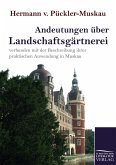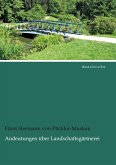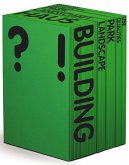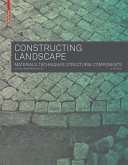"What does the landscape architect actually do as a design?” The authors investigate this seemingly simple question: What resources are available for designing open spaces? What part is played by conditions deriving from nature? How are locations and spaces created in the open air, how are paths routed and boundaries set, how are hard and soft materials used? Drawing on practical and theoretical experience, this introduction, often used as a textbook,reveals the central components of design and the intellectual paths followed in the design process.
"The book is not so much for reading but for doing. It plays with shapes, imagining how people feel in these shapes and seeing how shapes create a different experience of landscape. Vegetation can make the relief of a hill clearer, less clear, indistinct or hidden. The authors show this by sketches illustrating the text ... As an example of the way Loidl and Bernard set their readers thinking for themselves, I quote what they regard as good design: ‘The paradox of a good design solution: more uniformity needs more variety.’ Food for thought. Or read Open(ing) Spaces.” (Martin Woestenburg in scape, 2006)
"Worin besteht die entwurfliche Tat der Landschaftsarchitekten?"Dieser nur scheinbar einfachen Frage gehen die Autoren von Freiräume(n) nach. Mit welchen Mitteln wird Freiraum gestaltet? Welche Rolle spielen naturgegebene Bedingungen? Nach welchen Prinzipien entstehen im Freiraum Orte und Räume, werden Wege geführt und Grenzen gesetzt, harte und weiche Materialien verwendet? Vor dem Hintergrund der Erfahrungen aus Praxis und Lehre macht diese als Lehrbuch eingesetzte Einführung diezentralen Bestandteile des Entwerfens und der gedanklichen Wege im Entwurfsprozess sichtbar. "Ein Buch weniger zum Lesen als zum Machen. Es spielt mit Gestalten, stellt sich vor, wie man sich in diesen Gestalten fühlt, und sieht zu, wie die Gestalten eine andere Erfahrung von Landschaft schaffen. Vegetation kann das Relief einer Erhebung verklaren, verunklaren, verwischen oder verbergen. Die Autoren zeigen das in Skizzen, die den Text begleiten ... Ein Beispiel dafür, wie sie ihre Leser zum Selberdenken führen, ist dieses Zitat: 'Das Paradox der Güte einer Gestaltlösung: Mehr Einheitlichkeit erfordert mehr Reichhaltigkeit.' Was zum Nachdenken. Oder zum Lesen: Freiräume(n)(Martin Woestenburg, in 'scape, 2006)
"The book is not so much for reading but for doing. It plays with shapes, imagining how people feel in these shapes and seeing how shapes create a different experience of landscape. Vegetation can make the relief of a hill clearer, less clear, indistinct or hidden. The authors show this by sketches illustrating the text ... As an example of the way Loidl and Bernard set their readers thinking for themselves, I quote what they regard as good design: ‘The paradox of a good design solution: more uniformity needs more variety.’ Food for thought. Or read Open(ing) Spaces.” (Martin Woestenburg in scape, 2006)
"Worin besteht die entwurfliche Tat der Landschaftsarchitekten?"Dieser nur scheinbar einfachen Frage gehen die Autoren von Freiräume(n) nach. Mit welchen Mitteln wird Freiraum gestaltet? Welche Rolle spielen naturgegebene Bedingungen? Nach welchen Prinzipien entstehen im Freiraum Orte und Räume, werden Wege geführt und Grenzen gesetzt, harte und weiche Materialien verwendet? Vor dem Hintergrund der Erfahrungen aus Praxis und Lehre macht diese als Lehrbuch eingesetzte Einführung diezentralen Bestandteile des Entwerfens und der gedanklichen Wege im Entwurfsprozess sichtbar. "Ein Buch weniger zum Lesen als zum Machen. Es spielt mit Gestalten, stellt sich vor, wie man sich in diesen Gestalten fühlt, und sieht zu, wie die Gestalten eine andere Erfahrung von Landschaft schaffen. Vegetation kann das Relief einer Erhebung verklaren, verunklaren, verwischen oder verbergen. Die Autoren zeigen das in Skizzen, die den Text begleiten ... Ein Beispiel dafür, wie sie ihre Leser zum Selberdenken führen, ist dieses Zitat: 'Das Paradox der Güte einer Gestaltlösung: Mehr Einheitlichkeit erfordert mehr Reichhaltigkeit.' Was zum Nachdenken. Oder zum Lesen: Freiräume(n)(Martin Woestenburg, in 'scape, 2006)








